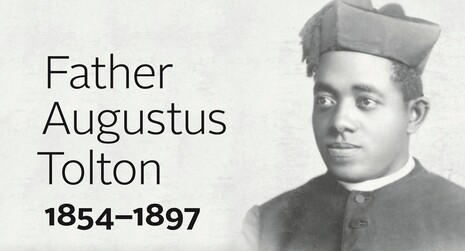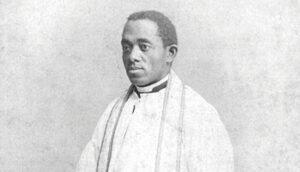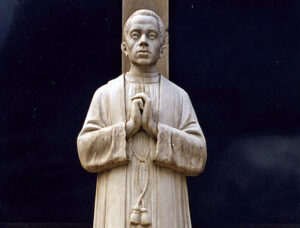
BORN A SLAVE
Venerable Augustus Tolton was born a slave and overcame tremendous discrimination to become the first Roman Catholic priest of African descent in the United States. Augustus was born in 1854 to slaves Peter Paul Tolton and his wife Martha Jane Chisley in Brush Creek, Missouri. Augustus was the second of their three children and was named after an uncle. Martha was Catholic, and the children were raised in the Catholic Faith, as much as their unfortunate circumstances allowed. When the Civil War broke out in 1861, Peter escaped in order to join the Union Army, knowing that getting caught could cost him his foot or worse and he died from illness before being sent to the front lines. Martha, with the three children in tow, escaped across the Mississippi River to Quincy, Illinois after being helped by some Union soldiers. Once in Illinois and, therefore, freed, the family went to work at a tobacco factory, doing the simple task of removing stems from the plants. A sympathetic Irish immigrant priest was able to enroll Augustus in St. Peter School during the months when the factory was closed. The pastor of the school, Fr. Peter McGirr, welcomed him, baptized him, and prepared the boy for his First Communion. Augustus’s admittance to the school caused many objections, but Fr. McGirr defended his decision and Augustus was allowed to remain. However, many of his lessons were given to him in private tutoring by priests, rather than in a large classroom. He trained as an altar server, learned the proper Latin responses, and applied himself to his studies, all while still working at the factory. He was Confirmed in 1870 at age sixteen and taught religion to other black children for several years.
CALLED TO THE PRIESTHOOD
As a young man, Augustus knew he wanted to become a priest, but not even one American seminary accepted him when he applied. He worked several odd jobs to help support his family, continued to be tutored, and spent his free hours in church praying in silence. He began taking classes at St. Francis Solanus College in Quincy in 1878.
With Fr. McGirr still working behind the scenes on his behalf, Augustus was at last accepted at the Pontifical Urbaniana University in Rome in 1880. At Rome, he at last experienced an environment where he was completely accepted and valued within the Catholic Church, and he flourished. He learned German, Italian, Greek and Latin and some African dialects. He developed his talents as a musician and it was discovered that he had a wonderful singing voice. He was ordained a priest in Rome at St. John Lateran, the papal cathedral and one of only four Major Basilicas, at the Easter Vigil of 1886. His first Mass was in St. Peter’s Basilica Easter Sunday. Although he had anticipated being sent for missionary work in Africa, he was instead sent back to the United States to minister to the often-neglected black Catholics.

HUMBLE, FAITHFUL SERVICE
Fr. Tolton’s first Mass on U.S. soil was at St. Benedict the Moor in New York City, with his mother in attendance. He returned to Quincy, but racial tensions there were high. He encountered humiliating opposition from both Catholic clergy and laity as well as Protestant blacks. He was reassigned to Chicago, arriving there in December 1889. There, he lived modestly and worked to provide assistance to the many poor in the area. By his goodness, he attracted many people to the Catholic Faith. He labored to establish a “Negro national parish” under the patronage of St. Monica on the city’s south side, a project for which he never seemed to grow weary. He received financial assistance from [St.] Katharine Drexel and others toward his building project and it was finished in 1893. The number of parishioners grew from dozens to hundreds. Known by most as “Good Father Gus”, he was particularly beloved due to his inspiring homilies and his beautiful singing voice. His health declined some, beginning in 1893, and during a summer heat wave, he died of heat stroke complications at a Chicago hospital July 8, 1897. He was just forty-three years old. Fr. Tolton was given two funerals – one in Chicago and another in Quincy. Both funerals drew large numbers of both clergy and laity. As per his request, he was interred at St. Peter’s in Quincy in the priest’s lot.

Venerable Augustus Tolton surely felt the deep wounds to his human dignity that the malice and prejudice of his contemporaries brought to his daily life. Yet, he was never known to harbor a grudge or to return an unkind word to his detractors. He was always known to be reverent and devoted to his ministry as a priest. He dedicated his priesthood to helping the poor and his people, who were having to endure the very same malice and prejudice as he. In 2010, Francis Cardinal George began the diocesan cause for Fr. Tolton’s possible canonization. In June of 2019, his life was declared to be one of heroic virtue, and he is now known as “Venerable”. Two reported miracles attributed to his intercession have been reported and are being investigated at the Vatican.
